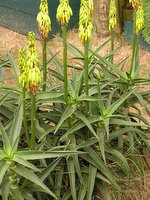
Aloes, have been grown as house plant's for years, with A.Vera the "Medicinal Aloe" probably being the most well known.
Usually regarded as half hardy or tender plants, here's one which breaks all the rules. Meet Aloe Striatula.
A native of South Africa, given the right conditions, A.Striatula will brush off anything our winters can throw at it and come up smiling in the spring.
So, if you've a passion for Mediterranean plants or just fancy something different give A.Striatula a try, you'll not be disappointed.
Growing A. Striatula is easy, its main requirements are, lots of sun and very well drained soil.
A.Striatula is best planted in a south facing position, give it as much sun as you can. Drainage should be first class, with no possibility of standing water. This is critical in winter. ( Mine grows in a south facing gravel bed with no winter protection. ) It's best planted out after all danger of frost has gone.
Water well during summer to get it established, then ease off for the autumn and winter.
Once established, A.Striatula is as drought resistant as they come and needs very little in the way of maintenance. I give my plant a few dose's of tomato fertilizer during the summer and that's it.
A Striatula also looks good in pots but beware, it tends to grow up and out like a shrub so, when large it all gets a bit heavy and awkward.
There's no need for any fancy composts, a one to one or even one to two mix of JI.no 2 or 3 and gravel will suffice. Whatever compost you use, err on the side of fast drainage and top off the pot with a good gravel mulch.
I'll be doing a blog on growing xeric plants from seed in the near future and this will include Aloes.
It's possible to grow A.Striatula from cuttings but great care is needed as any excess moisture will cause them to rot.
I used some new side shoots, about an inch and a half long for propagation, cutting them off close to the main stem.
I dusted them with sulpher powder and left them out for a couple of days to callous over.
I potted them up in a mix of J.I. seed compost and gravel, keeping them just moist.
After about six weeks, three cuttings had rooted and one rotted off.
If you're going to try propagating from cuttings, you must avoid excess humidity as it will kill your plants quicker than anything. Posted by: Mike.
A.Striatula really is a superb plant for the exotic garden. I've had little trouble with pests, other than ants which feed on the nectar rich flowers with relish. On occasions blackfly will feed on the flower stems and the odd slug has a nibble but nothing to get excited about.
Frost usually nips the leaf tips, turning them a tad brown, but as the plant starts back into growth this seems to disappear. All in all, a great plant.




